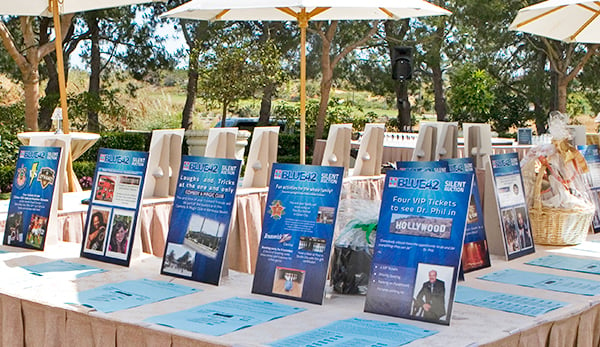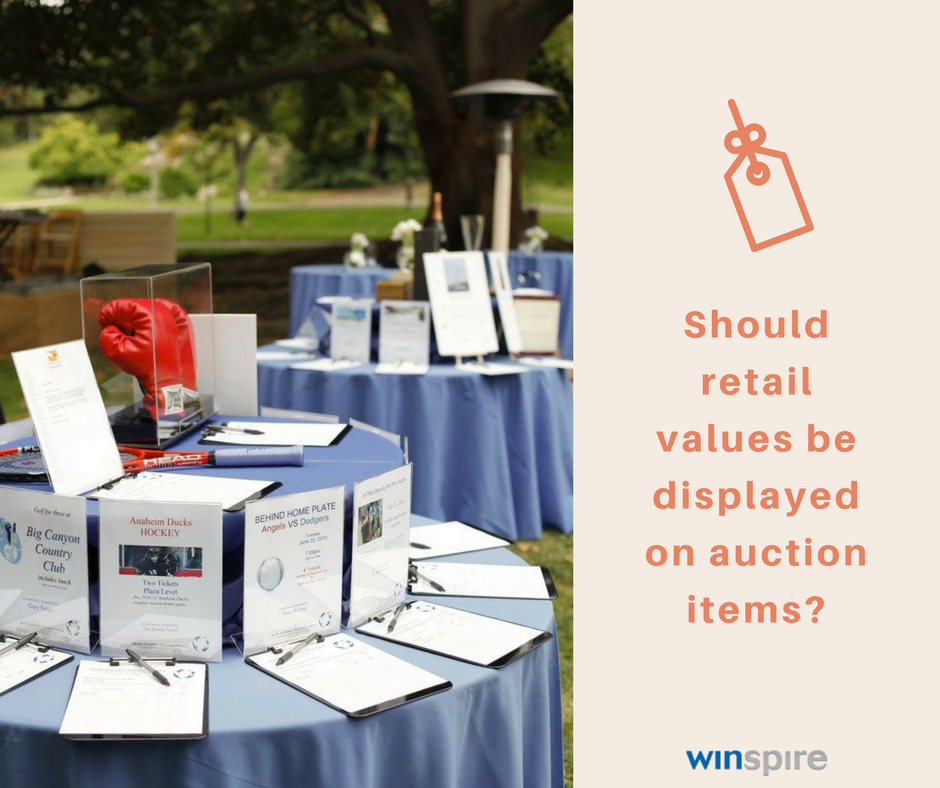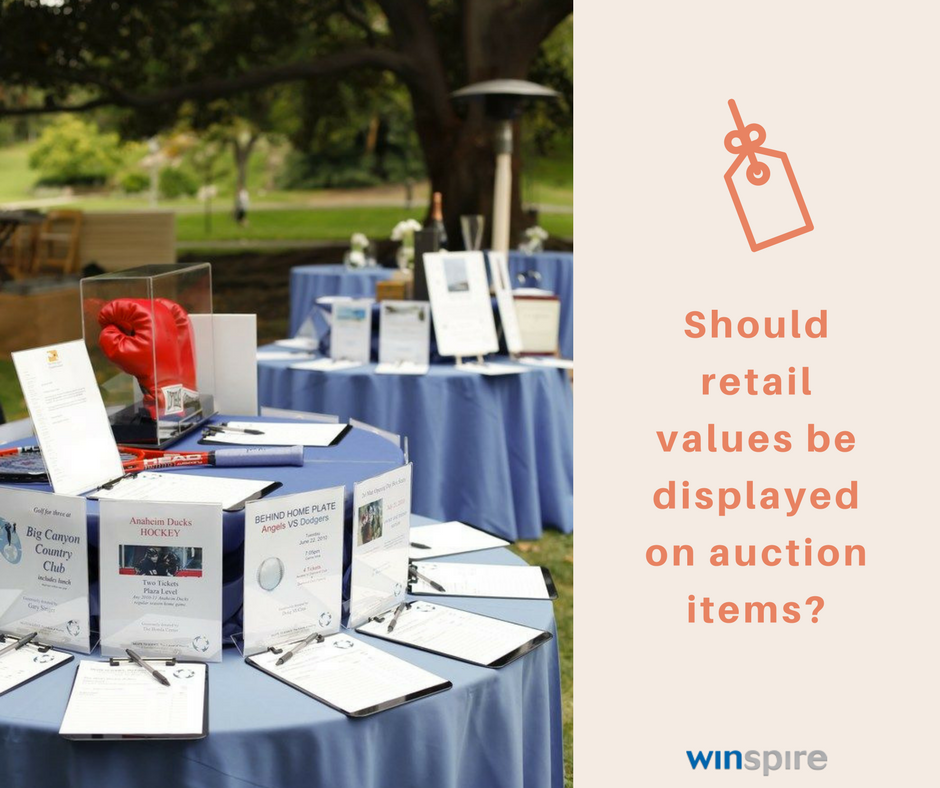Do you post retail values on your auction items’ bid sheets, display sheets, auction catalog and more? Do you leave them off? Does it matter?
There’s a wide range of opinions, and the decision can have big implications on how much you’re able to raise.
Read on to learn why and how organizations determine an item’s fair market value; the pros and cons of sharing those values with your donors; and our suggestions on when to display and when to omit prices.
Why calculate values
Whether or not you decide to display prices, it makes sense to know how much your items are worth at least internally.
For one thing, fundraising events should be guided every step of the way by a specific, ambitious fundraising goal. As procurement gets underway, you can use time-tested auction formulas to determine how many items are needed to reach that goal. You’ll do this by estimating values as items and donations roll in.
{{cta(‘a9a75277-b5b6-42b2-b1e0-65e3c7f7367d’,’justifycenter’)}}
Additionally, you may draw new people to your event by advertising an impressive total at your event -think “$30,000+ auction items up for grabs at the 2018 Charity Gala!”
Finally, donors may ask to view retail values after your event to determine the tax deductible portion of their purchase. Since laws vary by state, be sure to direct all inquiries to a tax lawyer or accountant. (You might also include a disclaimer on marketing materials like “Purchases are deductible to the extent allowable by law.“)
Tips to estimate values
Some items, like gift certificates and retail merchandise, will be very easy to valuate. A quick search on Google, Amazon or eBay will bring up exact matches or similar items, so you can assign a reasonable fair market value. Donors offering items or services, such as a beauty salon or private chef, can also provide the dollar value of their donations.
However, intangible lots—original art, private access, unique experiences and more—are much more difficult to price. After all, the exclusivity is exactly what makes these items so highly sought after by your patrons!
You can try ballpark-estimating components, but in many cases, the legal “value” of one-of-a-kind items ends up being the final bid: what someone is willing to pay.
To display, or not to display?
Now let’s get to the good stuff. Should retail values be displayed to donors, or should you leave them off?
The answer: It depends on the type of auction and nature of the item.
More specifically, make your decision(s) based on how displaying a price affects its perceived value. This is an essential principle of charity auctions that, once mastered, unlocks the key to raising more at events than ever before. Here’s what we mean.
Perceived Value
When it comes to an item’s value, there’s the actual “retail value”, or the objective number on a price tag that you’ll find at a retail store. At charity auctions, however, you have the power to bend the item’s “perceived value”, or how much a bidder is willing to pay, in your favor.
Perceived value has a lot more influence on final bids than retail values. Yet too many nonprofits get stuck chasing after the retail value, having a “take what we can get” mentality.
Factors that can influence perceived value include…
- Knowing a purchase goes toward a good cause.
- Unique items only available at a one-night-only event.
- Bucket-list items.
- Friendly competition and peer pressure.
- Sleek, professional displays.
- If displayed, retail value.
To/displays-101-impress-bidders-with-better-silent-auction-displaysday we’ll focus on the last factor. How can you leverage retail value (both its inclusion and omission) to raise an item’s perceived value? Here are a few guidelines.
Live Auctions
Generally speaking, we discourage nonprofits from revealing or publishing prices of live auction items in marketing materials. This includes the auction catalog, event site, PowerPoint slides and displays.
The reason: Displaying a starting bid tends to create a “glass ceiling” in the minds of your guests, limiting how far they’re willing to bid.
Plus, the unique items that tend to garner the most interest—that backstage concert meet-and-greet, school parking for a year, the appearance on your local newscast—are notoriously difficult to valuate.
Avoid the glass ceiling
“Think of when you’re driving home from work and need gas,” says Heath Hale, benefit auctioneer and recent Winspire webinar featured guest. “We pass up four gas stations to pay one penny less somewhere else, don’t we? Now imagine if gas stations didn’t have to put the cost of gas out front. We would just pull in and buy it.”
The same is true for your guests. Many are looking for a deal, and as soon as a number is put out there, bidders start calculating how much they’re willing to pay relative to that number.
Focus on messaging
Instead of promoting your event’s bargains, shine an unwavering spotlight on your cause.
Powerful, targeted messaging will not only increase live auction participation and bids—it will pay huge dividends in the silent auction, fund-a-need and every other revenue generator of the night.
Spend time thinking about how to frame the live auction around your cause, not the items themselves, and bidders will be more willing to pay top dollar.
{{cta(‘689b2d98-b14e-45ed-8730-efd270706c75′,’justifycenter’)}}
No-risk travel items
To position the night’s big-ticket items (like travel packages) to garner the highest possible bids, simply wait until the auction to establish a high minimum bid. (For our Experiences, we recommend starting at 20% over the package price.) Doing so establishes the item’s great worth, while minimizing how long bidders have to analyze the price.

Rather than trying to cobble together an inaccurate retail value, here’s how auctioneer Heath Hale focuses the audience on the cause.
“I do this all the time when a travel package in the live auction stalls out,” says Hale. “If a $3,000 Sonoma trip stalls out at $4,000 or $5,000, I’ll say, ‘Guys and gals, this is not about the package that we’re selling you. This is about the donation that you can make to the organization. You’re going to get a great experience because of your generosity.‘
“Bidding picks up and we can get to $6,000.”
By focusing on the messaging of the night, nonprofits that omit retail value are able to make hundreds and thousands of dollars in profit off consigned trips.
(One caveat: “The only time I do list the value in a live auction is jewelry,” Hale explains. “I don’t recommend selling jewelry or watches in live auctions, but if you must, letting people know a diamond necklace is worth $20,000 does encourage higher bids.”)
{{cta(‘bc4b315d-659b-4f3f-b7ab-190318c1f75a’,’justifycenter’)}}
Silent auctions

Our take: In most cases, skip the retail values and pre-populate bid sheets with good, reasonable minimum bid amounts instead.
You want minimum bids that are low enough to entice bidding, but not so low that you’d be disappointed if just one bidder was interested.
{{cta(’06aa1901-520f-407f-81ec-8c6180559fcc’,’justifycenter’)}}
“If you have, say, a signed football from Tom Brady, you might make the starting bid $500,” Hale explains. “You might think the value is priceless, but in reality you can probably pay $500 on eBay and get one. So get a good starting bid on your bid sheets, and that should cover most of your items.”
Another example: Say you have an Xbox with several games donated. You add up the components and determine this bundle retails for $300.
“If you put the retail value of $300, very few people will bid that amount because that’s just how we’re built in our minds,” Heath asserts. “So just put a starting bid of $150. This guarantees a significant return and is attractive enough to for people to start bidding.”
One instance in which displaying a value is helpful: subjective items, like an original sculpture, embellished kids’ crafts or basket of wine. Again it’s all about increasing an item’s perceived value, so if the value is likely to be underestimated by bidders, putting a fair price can help.
Bottom line: In our experience, most items, particularly big-ticket live auction items, fare better without retail values. Together with your committee, decide which items could benefit from displaying retail values, such as high-value items bidders may significantly undervalue.
And keep the focus on fundraising. This allows guests to have fun and feel good about their winnings.
{{cta(‘1a1cf4d1-a3b1-4e4c-8687-8512e667053f’,’justifycenter’)}}

